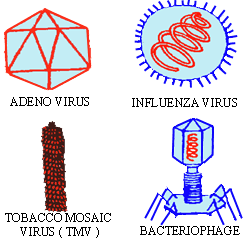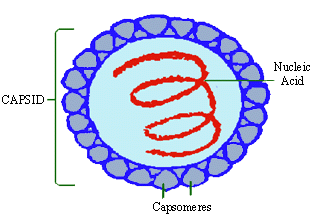|
PinkMonkey Online Study Guide-Biology
CHAPTER 14 : VIRUSES
14.0 Introduction
A five-kingdom classification system fails to classify
viruses because they are not considered to be living. They neither
reproduce independantly nor utilize energy.
Viruses are now defined as ultramicroscopic disease-producing
entities living in a host as obligatory intracellular parasites.
Brief history
Viruses were not known to biologists for a long time
due to thier ultramicroscopic structure although its presence was apparent
by infectious diseases which were not due to bacteria. They attracted
the attention of investigators in the 19th century when mosaic disease
(TMV) caused severe damage to commercially important tobacco crop.

Figure 14.1 A few different shapes of viruses
Mayer (1886) took the initiative and demonstrated
that the disease could be transmitted just by applying the sap of infected
leaves to the leaf of healthy plant. Mayer thought that the causative
agent was a bacterium. A crucial experiment was performed by Russian biologist
Iwanowsky (1892) who demonstrated that the sap of infected leaves,
even after passing through the finest porcelain filter (which prevents
bacteria to pass through), remained infective. He, therefore, ruled out
the presence of bacterium but could not think of any other causative agent.
Dutch microbiologist Beijerinck (1898) confirmed Iwanowsky’s findings
and suggested that the causative agents were not any submicroscopic particles
but the fluid itself which he called "contagium vivum fluidum"
which means contagious living fluid. This was later on called
viron (meaning poison) and the disease causing agent called virus.
Twort (1915) and d’ Herelle (1917) independently discovered
viruses attacking bacteria for the first time.
After the discovery of the ultramicroscope, the controversy
was finally laid down to rest when W. M. Stanley (1935), the American
biochemist, isolated the virus in crystalline form and showed that even
in this state it retains infectivity. These findings gave inspiration
to other scientists all over the world to study more aspects of viruses.
This marked the beginning of a new branch of science called virology.
General characters:
A large number of viruses are now known. They exhibit
diversity of form and infect a number of organisms. Despite diversity
of form and structure, they show the following important characteristics
common to all viruses:
1) They are ultramicroscopic disease-producing
entities.
2) They have no cellular organization and
also no metabolic machinery of their own.
3) They are simple in structure, basically
composed of nucleic acid wrapped up in a protein coat.
4) Nucleic acid is only of one type, either DNA
or RNA, but never both.
5) They are obligatory intracellular parasites
as they are completely inactive outside the host.
6) They multiply within the host by commandeering
the metabolic machinery of the host cell.
7) They are specific in action, i.e. they
always infect particular organ or organism.
8) They are incapable of growth and division.
9) They can be crystallized and even in crystalline
form, they retain their infectivity.
10) They are unaffected by antimicrobial antibiotics.
11) They may undergo mutations.
Size and shape : Viruses are minute entities,
even smaller than the smallest bacterium. They can be seen only under
electron microscope as small particles called virons. Being minute,
they are measured in millimicrons (1m m = 1/1000
m ). Generally they vary from 10 mm
to 300 mmð in size.
Viruses occur in three main shapes, viz.
(I) Polyhedral or spherical, e.g. adeno virus, herpes
virus etc.
(II) Helical or rod-like, e.g. tobacco mosaic virus,
(TMV), influenza virus, etc.
(III) Complex or irregular, e.g. bacteriophage, vaccinia,
etc.
Structure: The virus is composed of two major
parts: (I) Capsid and (ii) Nucleic acid.

Figure 14.2 A generalized structure of a virus
The capsid is the outer protective coat mostly
made up of specific protein. It protects nucleic acid from inactivation
by enzyme nuclease in the environment. It is often composed of many identical
subunits called capsomeres. The shape and arrangement of capsomeres
determine the shape of the virus. Some highly specialized viruses, for
example. influenza virus, mumps virus etc. show an outer covering called
an envelope which contains cell membrane obtained during exit of
the virus from its host cell.
The nucleic acid is in the central core. Unlike
living organisms it contains a single molecule either of DNA or RNA, but
never both. Nucleic acid is the only active part of a virus, hence viruses
are sometimes called "wandering genes". The infectivity of virus
is due to nucleic acid while host specificity is determined by the protein
coat.
The capsid in close contact with nucleic acid,
is known as nucleocapsid. Viruses may be enveloped or non-enveloped
(naked).
Chemical composition: A virus is a nucleoprotein,
i.e. mainly consisting of nucleic acid and proteins. Nucleic acid is--
either DNA or RNA, but never both. When only RNA is present, genetic information
is solely carried by RNA, which is the unique property of virus. The envelope,
if present, contains lipoproteins. The lipid is mostly derived from the
host plasma membrane while the protein is virus coded. Viruses normally
do not possess any biosynthetic enzymes.
|